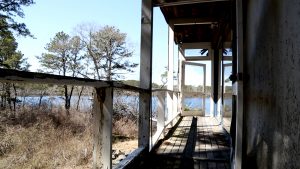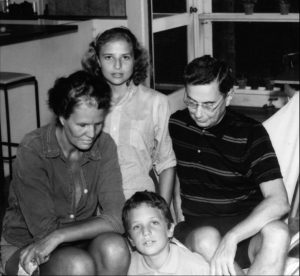

I remember the moment, eight years and five months ago, when I had the idea to make a film about my father. I was laying in the bottom of a canoe, drifting in Higgins Pond, near the ruin of what had been our summer home. I had come to Wellfleet to volunteer on a work crew. The house, designed by my father, was being restored by a non-profit as a prime example of mid-20th Century Modernism. I was not sure what had propelled me to fly across the country from California to do this. The house held terrible memories and had been lost to my family for forty years. The last time I had been inside I was an adult. The weight of those childhood memories crushed the breath from me and I had to leave quickly. Yet a decade later I sensed I had unfinished business there. I wanted to know the man my father was outside the constrained circle of my experience of him as a father. So began a long journey.
Last night at around 9:00 I clicked “export” on my film editing software. Overnight the high resolution master file of The Restless Hungarian Film was digitized. My journey had come to an end, a journey that began as research for a film, morphed into a book (Spark Press, 2019) and came full circle as the film was completed. During that time, my hair has gone white.
I procrastinated, or rather found creative and useful ways to make the work last. The three months of summer have been devoted to the final critique of my excellent board of advisors (see this previous post about them),securing rights for archive images and film footage, sound mixing, and color correcting the film
Obtaining archive rights and permissions was a nerve-wracking slog, punctuated by moments of connection and generosity. Mixing and color correction are highly technical processes that I have always delegated to specialists whom I regarded as members of an exclusive society of wizards.

But this time I couldn’t afford the wizards, so I went to school online to learn sound mixing. Such a small word, “mix,” such an enormous field of technology, protocols, options and decisions. Thank god for Daryn Roven, a sound engineer who works with my composer, Ed Bogas. Though we’ve known each other for many years, Daryn and I only became intimately acquainted this summer. As my guide and tutor, he logged onto my Zoom call twice a week to grade my “homework” and teach me about the equalizers, compressors, “wet” and “dry” sound, automation, and how to hunt for the best frequencies, the sweet spot in each of the forty-five separate voices in my film. What made this possible virtually was an app that streamed the sound from my computer directly to the speakers in Daryn’s studio. It enabled us to hear to the exact same sound, uncontaminated by the audio distortions on Zoom. Daryn, who has done this for 35 years, has the ear. I’d say, “Daryn, please put on your bat ears,” and then I’d play a sequence that I thought I had made perfect. He would listen, then teach me how to hear subtle errant sounds and delicately excise them without compromising the whole. He called it sculpting. It was magic. I enjoyed immensely the process of learning while working with my teacher, not to mention the satisfaction of listening together to the completed mix.
It’s poignant that those of you who watch The Restless Hungarian will see it on your small screen, hearing only a fraction of what I am rhapsodizing about. Most computer speakers simply cannot reproduce the tonal and dynamic range we once experienced in a movie theater, but I like knowing it is there.
For eight and a half years, I allowed myself to do what I had never done before on any film or creative project; give no thought to the marketplace. I did not want my perception of how an audience might respond to contaminate my judgement. It is perfectly fine, legitimate, and even advisable, to think deeply about your audience when you are making a documentary about external conflicts, events, people, or an important cause. But in making a film about one’s own family, to have the courage to be honest, you cannot think about what kind of impression you are going to make. Fortunately my advisors understood this, and helped to give me the courage to see deeply and be honest.

So what happens now? A moment I have lived and worked towards for so long… has finally come. It is time to start submitting The Restless Hungarian to film festivals. Please stay tuned.
Jacqueline Tully
July 30, 2022 at 8:36 amI saw your film yesterday at the JFF. It is wonderful and courageous. Thank you so much,
Lea Worcester
November 13, 2021 at 5:07 pmCongratulations, Tom. We so thoroughly enjoyed listening to you read from your beautiful book , and now look forward to seeing the film. Best of luck with it!
Cheers, Lea and Chad
Holly C.
October 16, 2021 at 2:22 pmHurray, congrats, Tom!
Tom Paul
October 11, 2021 at 3:42 pmCongratulations Tom! Your vision and your tenacity to complete this is awesome and admirable. Good luck with the film festival submissions.
Kelly Bowen
October 11, 2021 at 2:33 pmCongratulations Tom! The book was wonderful. Look forward to the film.
lorraine Whitman Check
October 11, 2021 at 7:36 amMazel tov Tom! You have lived, eaten, breathed this project for so many years…understanding/capturing your father. I’m grateful to have known him. I’m grateful to have known you and to have added just the tiniest bit to this quest. Like others, I am so very anxious to see the finished product. Bonne chance.
Ernie
October 9, 2021 at 4:49 pmCongratulations and good luck!
Jim Pesout
October 9, 2021 at 7:51 amThis is a monumental accomplishment. I hope you not only take pride in the film but also your dedication and perseverance in creating it. I look forward to seeing it.
Ceecee
October 8, 2021 at 1:08 pmCongratulations dear friend. We can hardly wait to view your masterpiece!
Jim Mangum & Family
October 8, 2021 at 1:03 amCongratulations
Tom this is awesome We look forward to hearing about the film festivals
Rhoda
October 7, 2021 at 11:22 pmDecades ago, when I was a young resident and newly minted Attending Physician, I could on rare occasions bring a friend into the hospital with me when i was on-call. This was back in the day when the senior physician in the Labor and Delivery Suite was king (or most recently queen) and no one questioned my authority to bring a lay person into the operating room. The few people I did this for were immersed into a real life hospital drama and were so grateful for this unique experience.
Reading your posts, talking to you, over these years, reading your book and soon to see your movie have been a similar intimate immersion into the life of a film maker and more specifically, the film maker Tom Weidlinger. I am grateful for this unique experience.
Mark Bollobas
October 7, 2021 at 10:07 pmCongratulations, looking forward to watching it sometime!
Jackie Stillwell
October 7, 2021 at 7:17 pmWhat a journey! Congratulations on the inner and outer work you have bravely embraced! xoxox
Robert Colopy
October 7, 2021 at 6:23 pmDear Tom,
My wife, Gia, and I have spent a few summers in the Weidlinger House loving each time more than the last. Gia gave me your Dad’s biography as soon as it was published and we’re thrilled to hear your film will soon be available. Cathartic and heartfelt your family’s poignant story touched me deeply it resonates still.
Sylvia Paull
October 7, 2021 at 2:10 pmCongratulations. You look the same as you did as a child and I’m sure you’re still the same in many ways as well. In that photo, your dad is looking at you with complete love, and your mom looks troubled. The photo presages what is to come in the film.
Laszlo Kadar
October 7, 2021 at 6:21 amHello Tom, congratulation on finishing this huge project, good luck. You may remember me we met in Budapest and you invited me for the shooting. It was the first time I had witnessed how much work it takes to shoot one scene. I was making some pictures about the shooting and at one point I become a “film star” because I ended up in one of the retakes.
I know you were busy for years, but if ever go to Hungary or in the New York area, let have a coffee together..
Good luck.
Laszlo kadar
lkadar2yahoo.com, 732 51-7811